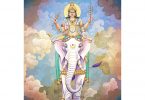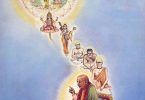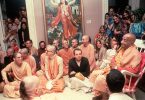Q. 1. If worship of Srimati Radharani is so important why does Lord Krsna not talk about it in the Gita? I indicated that the Bhagavatam references to the glory of Radharani as does Sri Caitanya Mahaprabhu.
[Answered within the next Q/A. See below.]
Q. 2. Since worship of Sri Sri Radha Krsna is so important and we belong of the Brahma-Gaudiya-Madhva-sampradaya, why is that the temple founded by Madhvacarya (i beleive this is in reference to the temple at Udupi) does not have Sriamti Radharani?
Answer by Romapada Swami: Bhagavad Gita is the preliminary book for spiritualists and it is read by all the sampradayas, and where Bhagavad Gita ends Srimad Bhagavatam begins, and where Srimad Bhagavatam ends Caitanya Caritamrta begins. Though name of Radha is not mentioned directly, Srila Prabhupada indicates that in the explanation to the verse “mahatmanas tu mam partha daivim prakritim asritah” that daivim prakritim asritah refers to pure devotees taking shelter of the para prakrti, the internal potency of the Lord called Lakshmidevi, Sitadevi, Srimati Radharani or Srimati Rukminidevi by which they become great souls or mahatmas. So there is indirect mention.
In the Bhagavatam too there is not direct mention of Radharani’s name because if Sukadev Goswami had mentioned Her name he would not be able to complete his recitation of Srimad Bhagavatam; he would have been lost in an ecstatic mood! Therefore there is only one place that Radharani’s name is mentioned and that too indirectly. “Truly the Personality of Godhead has been worshiped by Her. Therefore Lord Govinda, being pleased, has brought Her to a lonely spot, leaving us all behind.” Srimad-Bhagavatam 10.30.28.
Beginning from Madhvacarya down to the spiritual master of Madhavendra Puri, the acarya named Lakshmipati, there was no realization of devotional service in conjugal love. Sri Madhavendra Puri personally experienced and introduced the conception of conjugal love for the first time in the Madhvacarya- sampradaya, and this conclusion of the Madhvacarya-sampradaya was revealed in fullness by Sri Caitanya Mahaprabhu when He toured southern India and met the Tattvavadis, who supposedly belonged to the Madhvacarya-sampradaya. (CC Madhya 4.197)
Radha Krishna worship is a very intimate form of worship; although there were many advanced Vaisnavas even in other sampradayas who worshipped Radha Krsna, this spontaneous mood of worship was never freely distributed until Lord Caitanya came. The mood of Udupi Krsna worship is in the mood of awe and reverence.
Below a question that was answered in Inquiries which also sheds further light:
Digest 7F Q. In olden days as far as I know people used to worship Lord Sri Krishna only. I think it was in our (ISKCON) spiritual line Sri Sri Radha Krishna are worshiped?
Answer by Romapada Swami: You have asked a very interesting question, regarding the introduction of Radha and Krishna worship, as opposed to worship of Lord Sri Krishna without Srimati Radharani. For your information, Radha Krishna worship is also found in the Nimbarka Sampradaya as well. The Vraja dham affection of conjugal love between Radha and Krishna and the very confidential mood of service found in Vraja in general is enhanced by the worship of Radha Krishna. In fact, it is by the mercy of Srimati Radharani, and the other associates of Vrindavan, that one can enter into the confidential understandings of the love of Krishna that is known in Vrindavan only. Worship of Krishna without His hladini sakti, Srimati Radharani, which is found in many places in India, not only in the past but even at present, permits one to enter into the aisvarya mood of worshipping the Supreme Lord in opulence. It is understood that some parts of the paraphernalia of Lord Krishna represents the internal potency of the Lord. For example, in the Vallabha sampradaya the mala of Sri Nathji is understood to be the manifestation of the Lord’s internal potency, or Srimati Radharani. In this way, worship is also performed, but in a mood of opulence rather than in a mood of intimacy, as the worship of Radha Krishna facilitates.







